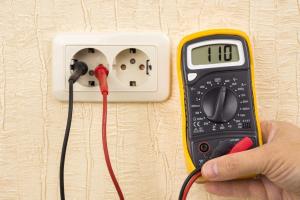Mastering the Voltmeter: A Comprehensive Guide to Accurate Measurement

-
Quick Links:
- 1. Introduction to Voltmeters
- 2. Types of Voltmeters
- 3. Understanding Voltage Measurement
- 4. How to Use a Voltmeter
- 5. Practical Applications of Voltmeters
- 6. Safety Precautions
- 7. Troubleshooting Common Issues
- 8. Case Studies and Real-world Examples
- 9. Expert Insights
- 10. FAQs
1. Introduction to Voltmeters
The voltmeter is an essential instrument in electrical engineering and DIY electronics. It allows users to measure electrical potential difference between two points in an electric circuit. Understanding how to use a voltmeter can empower you to diagnose electrical issues, perform maintenance, and innovate in your projects.
2. Types of Voltmeters
Voltmeters come in various types, each suited for different applications. The two primary categories are:
- Analog Voltmeters: These use a needle gauge to indicate voltage levels. They are often preferred for their simplicity and reliability.
- Digital Voltmeters: These provide numerical readings and are generally more accurate and easier to read than their analog counterparts.
2.1 Comparison Table
| Type | Advantages | Disadvantages |
|---|---|---|
| Analog | Simplicity, no batteries required | Less accurate, difficult to read |
| Digital | High accuracy, easy to read | Requires batteries, can be more expensive |
3. Understanding Voltage Measurement
Voltage is the measure of electric potential difference and is expressed in volts (V). It’s crucial to understand the concept of voltage in order to effectively utilize a voltmeter.
3.1 Ohm’s Law
Ohm's Law is fundamental in understanding electrical circuits, expressed as V = I × R, where V is voltage, I is current, and R is resistance.
4. How to Use a Voltmeter
Using a voltmeter involves a straightforward process, but attention to detail is crucial for accurate readings.
4.1 Step-by-Step Guide
- Gather Your Tools: Ensure you have a voltmeter, leads, and safety equipment.
- Select the Appropriate Setting: Choose AC or DC voltage based on your circuit.
- Connect the Leads: Attach the black lead to the COM port and the red lead to the VΩmA port.
- Measure Voltage: Touch the probes to the circuit points. The screen will display the voltage value.
4.2 Common Mistakes to Avoid
- Incorrect settings (AC vs. DC)
- Improper connections
- Ignoring safety precautions
5. Practical Applications of Voltmeters
Voltmeters are used in various fields, including electronics, automotive, and home appliance repairs. Here are a few examples:
- Testing batteries
- Diagnosing electrical faults
- Measuring the output of solar panels
6. Safety Precautions
Safety is paramount when working with electrical components. Always ensure:
- Your voltmeter is rated for the voltage you are measuring.
- You are wearing appropriate safety gear.
- You are aware of the circuit's potential hazards.
7. Troubleshooting Common Issues
If you encounter issues while using your voltmeter, consider the following troubleshooting tips:
- Check the battery of the voltmeter if readings are inaccurate.
- Inspect leads for damage or wear.
- Ensure proper settings are selected.
8. Case Studies and Real-world Examples
In this section, we'll examine real-world scenarios where voltmeters proved essential for troubleshooting and maintenance:
8.1 Case Study: Automotive Diagnostics
A mechanic used a digital voltmeter to diagnose a faulty ignition system in a car, identifying the voltage drop across the ignition coil.
8.2 Case Study: Home Electrical Repairs
A homeowner used an analog voltmeter to troubleshoot flickering lights, discovering a loose connection that was causing voltage irregularities.
9. Expert Insights
We interviewed experts in electrical engineering who emphasized the importance of mastering voltmeter usage for both professionals and hobbyists. They suggest regular practice and familiarization with different voltmeter models to enhance proficiency.
FAQs
1. What is the difference between AC and DC voltage?
AC (Alternating Current) voltage varies over time, while DC (Direct Current) voltage remains constant.
2. Can I use a voltmeter on live circuits?
Yes, as long as the voltmeter is rated for the voltage and you follow safety precautions.
3. How do I know if my voltmeter is working correctly?
Test it on a known voltage source, such as a battery, and check if the reading is accurate.
4. What should I do if my voltmeter gives an error reading?
Check the connections, settings, and battery life of the voltmeter.
5. Is it safe to measure high voltages with a standard voltmeter?
No, always use a voltmeter that is rated for the specific voltage you are measuring.
6. How often should I calibrate my voltmeter?
Calibration should occur regularly, depending on usage frequency and manufacturer recommendations.
7. Can I measure voltage in a power outlet?
Yes, but ensure you are using a voltmeter rated for household voltage levels and always follow safety protocols.
8. What is the best voltmeter for beginners?
A simple digital voltmeter is often the best choice for beginners due to its ease of use and accuracy.
9. Are there any apps that can measure voltage?
Some smartphone apps can measure voltage using external sensors, but traditional voltmeters are recommended for precise measurements.
10. What are the consequences of incorrect voltage measurement?
Incorrect measurements can lead to faulty repairs, damage to electrical components, and safety hazards.